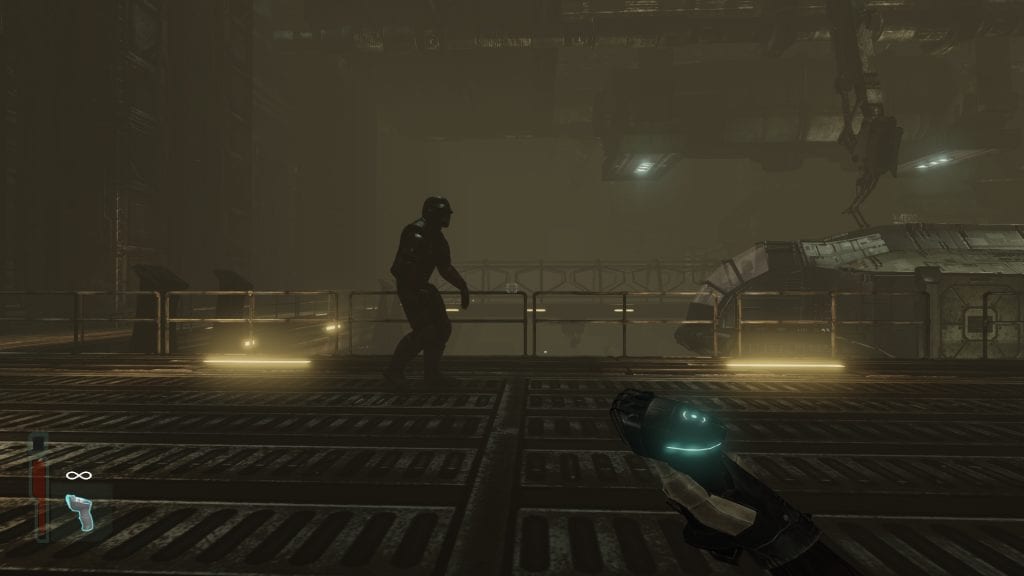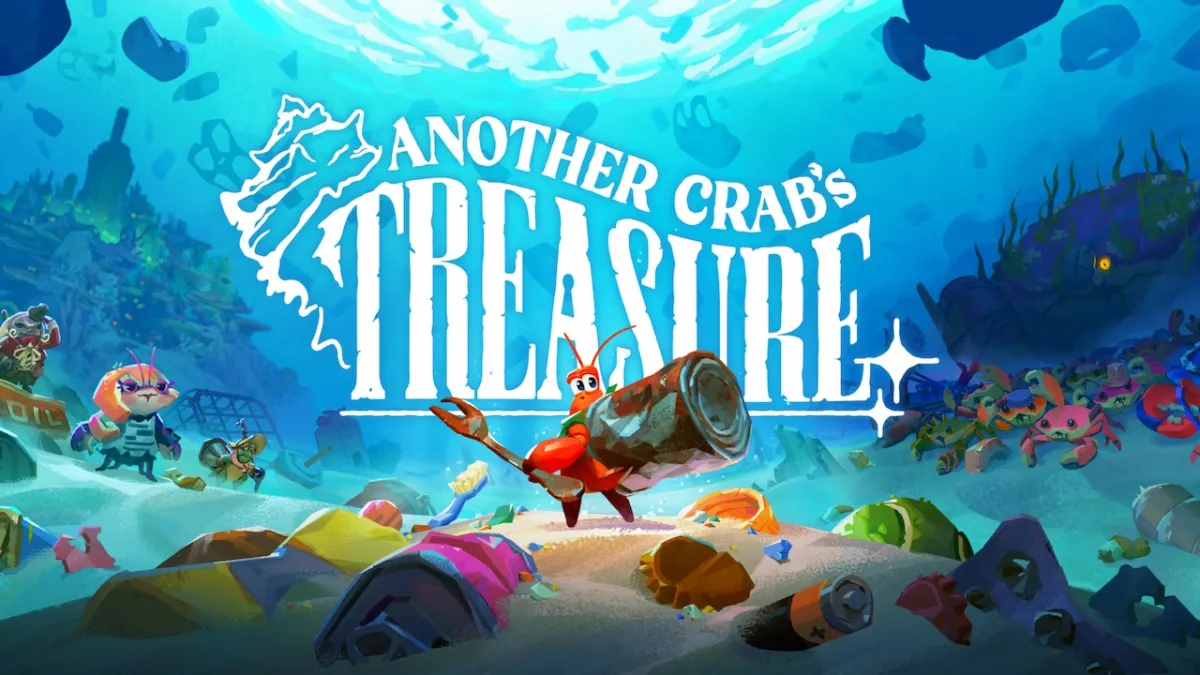Before this review really begins creeping through the industrial bowels of Solarix’s mining colonies, space vessels and biolabs, here’s a brief disclosure of information. Prior to release, I was one of a handful of people who provided some (voluntary, and non-compensated) critique to creators Pulsetense on an alpha build of this game.

It may look like I’m holding a Scalextric controller, but that’s actually Solarix’s sci-fi blackjack.
Solarix wears Looking Glass Studio and Irrational influences all over its space-suited sleeves, but while the System Shock series comes up a lot in promotional materials, the game is most closely emulating the original Thief. Your character is pre-defined (there are no RPG stats) and stealth is not an optional style of play; it’s absolutely mandatory.
Granted, Solarix casts you as an amnesiac with a gun in a situation where complex Artificial Intelligences and a deadly infection have run wild. That’s all pretty System Shock. But the moment to moment activities of skulking in shadows, extinguishing light sources (with gun-shots rather than special arrows,) bopping troublesome enemies on the head from behind, and protagonist Walter’s relative weakness in a fight are all straight from the Thief: The Dark Project stealth design handbook. There’s even a pseudo light-gem.
This love-in with classic 90s gaming extends to other areas too. Task guidance is straightforward, but minimal. Using Walter’s electro-shock device on the back of a foe’s bonce requires you to actually get behind them and line it up correctly; none of this “press X to takedown” business. And though players are given access to a top-down map of the areas they’re creeping around, these plans are suitably vague and do not show Walter’s current location.
It’s welcome, and somewhat rare, to find a game unafraid to cast its players in at the deeper end of things in this manner.

In case you needed any more convincing of the Looking Glass roots, Solarix has keys dedicated to leaning.
Solarix is not quick to reveal its plot, either. Nor the connections between its five key players. Instead, it expects you to be patient and spreads clues throughout audio logs and information terminals. Some of these are found with a little off-the-path exploration, others beamed directly into Walter’s ears at key junctures. Popping into side buildings or out of the way corridors can also reward players with precious ammo, less precious health kits (I had about twelve of these by the end of the game,) or, in some cases, nothing at all.
Progression is not complicated, as missions give players a step-by-step framework of objectives, but still takes a bit of thought to work through. An early chapter (one of twelve, which took me 6-7 hours in total) provides the clues that an access card and engineer’s hand-print will be needed to continue onwards. All the necessary tools are provided, but it’s left to the player to figure out how to put the pieces together. Or disassemble the pieces, as the case may be.
Solarix has a tendency to stay a bit too faithful to the source material, however, meaning that Walter can quite often get himself stuck behind a bit of geometry or caught on a seemingly insignificant box. This is just like the good old Dark Engine days of Thief, but also rather annoying when it screws up some masterful sneaking or simply traps you in place and forces a reload.

There’s a bit of hacking to be done too, which in classic 90s style involves waggling your hacking device at the machinery for a bit.
Having to reload is no joke in Solarix, because the game (unfortunately) opts for a checkpoint system rather than manual saves. Whilst it’s true that this removes any temptation for save-scumming, and means any decision to investigate a side-area is actually a risk, the relative space between checkpoints can also act as a deterrent to exploration. Stealth games are slow, methodical affairs, where one mistake can cost you significant progress. If a player hasn’t seen an auto-save point in twenty minutes, they may be wary about experimenting with different stealth techniques or straying too far from the mission objective.
A few of these checkpoints are also quite poorly placed. One of them had a mission-critical object in one direction, and the rest of the level in the other. Every time I died, it meant wasting a trip to get the necessary object before continuing on.
Getting Walter killed and having to replay a section is just about tolerable when the death is the player’s own fault. Not so much when it’s the result of bizarre AI activities. The guards in Thief were relatively straightforward to ‘read’ in terms of how alert they were, how they were likely to behave in certain circumstances, and so on. It’s vital that the player understands these things, in order that they can formulate a plan on how best to avoid a confrontation.
The AI foes in Solarix can be … eccentric, to say the least.

This guy MIGHT go back to his patrol route, or he might just spend the rest of the day floating over barrels.
Sometimes you’ll approach an area and find an AI soldier or space-suited zombie (these are the game’s main encounters) just walking aimlessly in place. These are actually the most dangerous foes, because without a patrol pattern you have no idea when (or if) they might suddenly decide to ‘right’ themselves and turn around, or wander off elsewhere. If you’re especially unlucky, they might be doing this in a doorway that you absolutely have to go through. In which case, there’s no way of ghosting past and you’ll have to hope you have a firearm and some limited ammo to spare.
The AI also likes to float above throwable objects. You can exploit this to your own amusement by throwing something at them and then watching as they attempt to step across and catapult themselves a short distance up in the air.
Most of Solarix’s enemies are infected or unhinged in some way, which perhaps suggests why they react on a hair-trigger. There isn’t really any kind of alert escalation, just soldiers who will see a flash of something in a darkened corner and unload an endless stream of automatic fire with pinpoint accuracy.
In almost all cases, when the AI is forced to acknowledge or interact with the player, there’s a reasonable chance they’ll start behaving in an unpredictable or bizarre manner. If you were feeling charitable, you could say this adds further incentive to never be seen and ramps up the tension. If not, you’d conclude it’s goofy-looking AI which does the atmosphere of the game few favours.

Performance on my i3-2100/8GB/7870 box was mostly sat at 60fps, until this level happened and brutally murdered the frame-rate.
That’s a great shame, as Pulsetense are clearly fans of the Looking Glass approach to sound and level design – even if they’re not quite able to replicate it.
Solarix’s sound design is robust enough to communicate directional footsteps to the player, giving them an idea of how close a roaming enemy might be and whether said foe is approaching or walking away. Voice acting of the game’s various audio logs is of a very high standard, and helps to sell the unsettling nature of Walter’s situation. The score writhes and pulses in the background, nagging at the nerves.
The in-game audio is at its best when it’s cultivating feelings of uncertainty and unease. When it goes for straight horror, things fall flat. Somebody on the team made the dubious decision to include a bunch of canned scream effects, which always trigger at exactly the same places in a given level. As well as being awfully cheesy, these can sometimes ‘override’ other sounds (like audio logs,) meaning you have to track back and trigger them again.

I could just let him go past, but that wouldn’t satisfy my pathologically need to render everything unconscious.
System Shock 2 and Thief: The Dark Project are regarded as games with examples of peerless level design. In part, this is because they made every space feel lived in. Thief’s mansions are believable spaces, with kitchens, cellars, bedrooms and little dioramas of life, like discarded wine glasses by a fireplace. Abandoned places like The Lost City also possessed a distinct ecology. Likewise, Irrational took incredible care in making sure the med-bays and engine rooms on their post-crisis space vessel were in spots which made sense.
Solarix makes an honest effort to recreate this feeling with its refineries, military bases and abandoned space stations, but comes up short. The layouts in this game primarily serve to channel players to their objectives (even to the extent of gating off areas until Walter has performed a certain task,) but there are definite glimpses of attempts to make the spaces feel as if they were functional prior to everything going to hell. Solarix is better at providing a sense of scale beyond its mission areas, with distant, looming industrial structures and off-limits parts of space vessels. Thief achieved much the same thing, giving the impression of an expansive, vibrant city with just a few modeled streets.
Few PC games are as daunting to recreate as the Thief-System Shock-Deus Ex triumvirate of ‘immersive sims,’ and few come with such sky-high player expectations. Solarix’s attempt to meld the mechanics of Thief with the AI-driven plot of System Shock 2 doesn’t (and perhaps never could) meet those expectations, but it’s gratifying that there are contemporary studios inspired by the late, great Looking Glass. With a much more stringent QA pass and more reliable AI, Solarix could be considered a rough gem tribute on limited resources. As things stand, you need to be able to tolerate your fair share of geometry bugs, glitches and AI oddities to get the most out of this worthy but troubled title.




